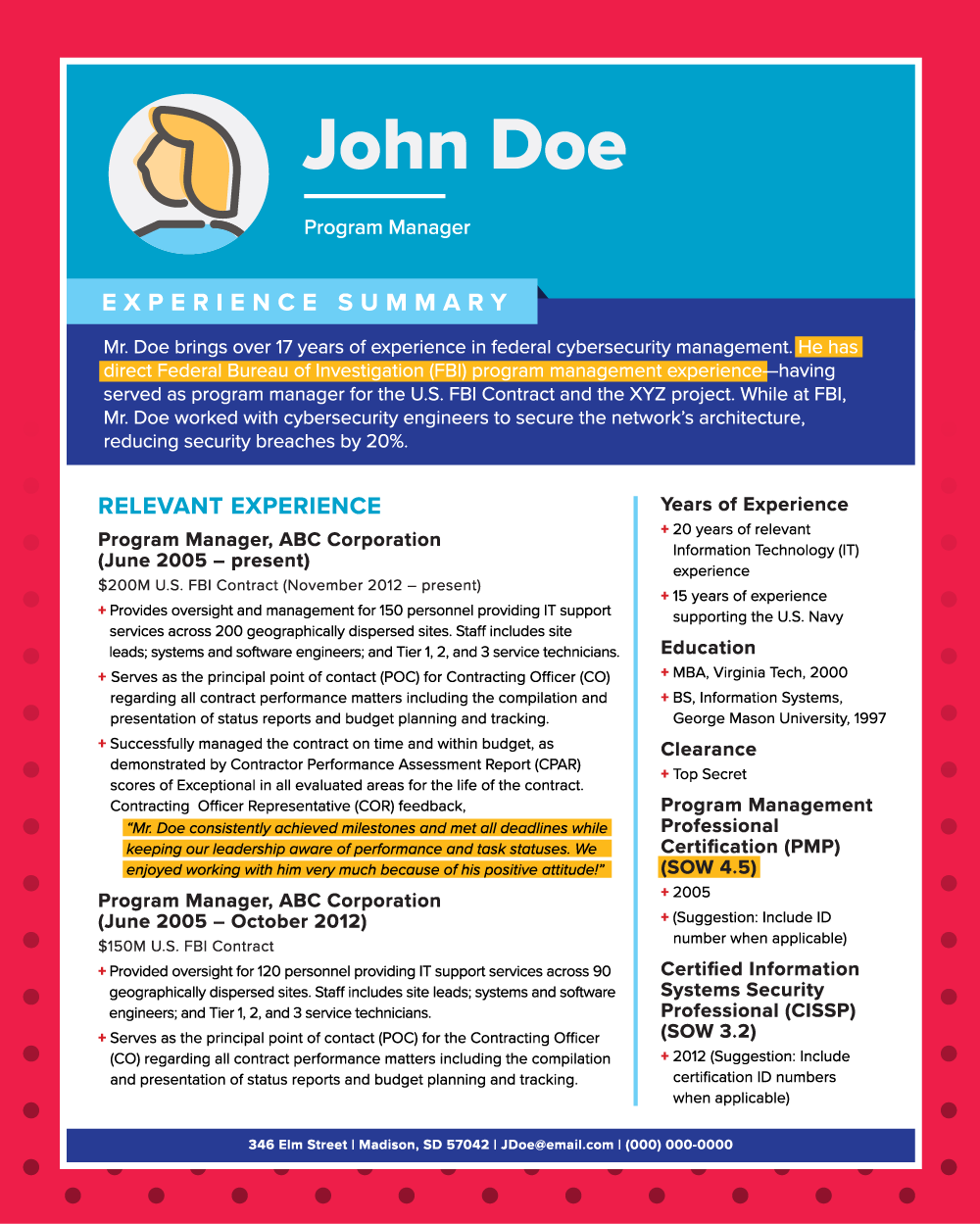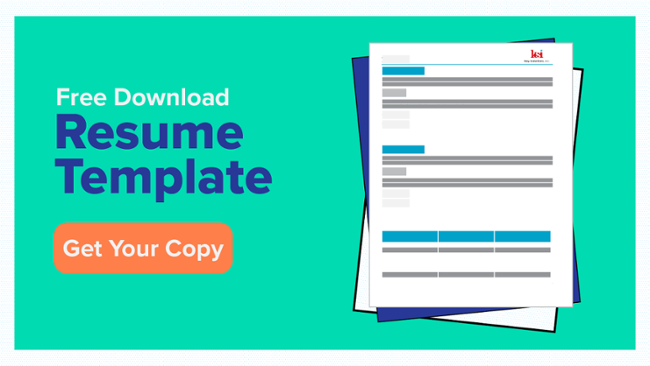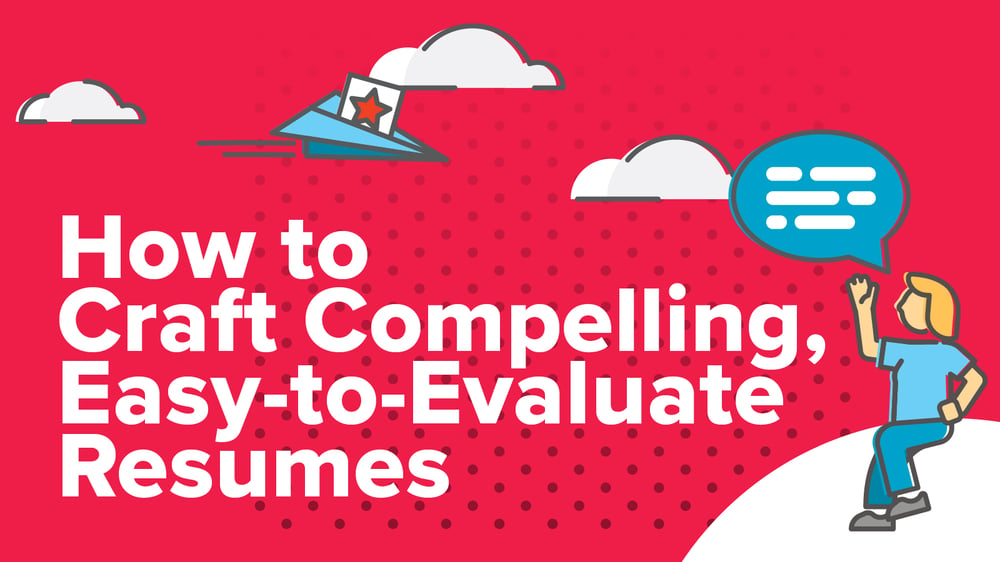
Federal proposals often require contractors to include resumes of their proposed team.
These resumes demonstrate the contractor's capability to bring qualified personnel to carry out the contract's tasks. Although resumes may not be as important during the evaluation as the Technical Approach or Pricing, when done correctly, they show a contractor's understanding of the client's needs and requirements.
Since Key Personnel will be performing the contract work, the customer needs to feel confident that their experience and capabilities qualify them to perform their assigned role. Because of this, resumes may even become the deciding factor between a win or loss.
Typical requirements for federal proposal resumes include:
- Relevant Experience
- Education
- Certifications
- Training
A compliant template is a baseline. To make a resume responsive to customer needs, it must also be compelling. It is essential to demonstrate that the personnel fulfills the required qualifications and that their experience enables them to complete contract tasks efficiently while reducing risk for the customer. This approach addresses solicitation requirements and gives the customer confidence that the contract will be successful.
To accomplish this, in this article we will focus on three key points:
- Create resumes that are compliant
- Create resumes that are compelling
- Create resumes that are easy to evaluate
1. How to Develop a Compliant Resume
Create a compliant resume template and organize resumes according to the instructions and evaluation criteria.
First, create a compliant resume template to present candidates. Then, use resume templates for the solicitation when they are available. If a template is not provided, always start with the instructions and evaluation criteria, then move through the scope of work to understand areas to highlight when demonstrating the candidate's experience; this is key to drafting proposal resumes.
Evaluators will be familiar with the solicitation and expect to see it reflected in the contractor's responses. If an outline is not provided, mirroring evaluation factors is a reliable technique to ensure compliance. Draft a readable, compliant layout conforming to any formatting requirements in the solicitation.
Be sure to check all relevant proposal sections for hidden requirements:
- Section L Instruction, Conditions, and Notices to Offerors or Respondents: Provides instructions for proposal preparation, format, organization, content, and length
- Section M Evaluation Factors for Award: Provides the evaluation process, factors, and relative importance of the factors
- Section C Scope of Work (SOW): Describes the work to be performed on the awarded contract
- Section H Special Contract Requirements: Provides contract requirements not listed in Section I or other sections of the solicitation, frequently containing key personnel qualification requirements and attachments to the solicitation.
Read solicitations entirely and thoroughly to ensure each requirement is addressed. Also, look for customer's needs woven throughout other sections. For example, qualifications for labor categories may not be explicitly written as a requirement, but they may note areas to mention in candidate resumes. Additionally, consider the background information of the soliciting agency to draw a clear connection between a candidate with relevant agency experience.
Create a compliance matrix for each labor category.
While preparing resumes for a proposal, review them against a compliance matrix. A compliance matrix confirms that each requirement is addressed and reduces error by not relying on one's memory. These matrices can also be sent to reviewers as a quick reference of the requirements.
Respond to every requirement explicitly.
Address each requirement as per the solicitation. Use language from the solicitation and include the candidates' experience as examples of their qualifications. To aid in gathering this information for the resumes, the KSI Advantage™ Capture & Proposal Guide offers Sample Key Personnel SOW Checklists that map candidate experience to the statement of work (SOW) requirements. These checklists can be expanded to include other qualification requirements as well.
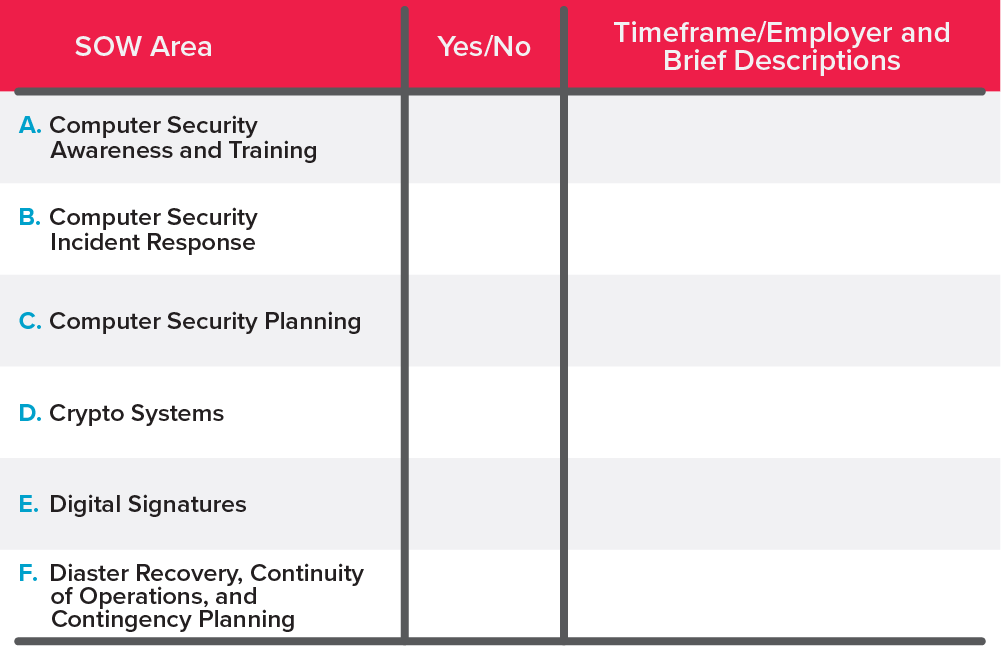
2. How to Develop a Compelling Resume
Resume writers are responsible for convincing evaluators that the proposed candidate is capable and qualified to support their contract. To do so, highlight accomplishments that matter to the customer. Leverage customer intelligence from the business development team (or person) to build a targeted resume that will resonate with the customer.
Quantify and qualify resume experience.
It is necessary to quantify and qualify experience to substantiate claims. Therefore, the more specific the experience in a resume is, the easier it is for an evaluator to understand the context and value of the experience.
Here is an example of how to quantify and qualify resume experience.
Original: Mr. George has supported numerous efforts as a resume writer.
Revised: Mr. George has completed 30 resumes within a 2-week required turnaround.
If you can include positive results of a candidate's performance and contribution to projects in their position, this is even better!
Example: Mr. George has completed 30 resumes within a 2-week required turnaround, which received an "Exceptional" evaluation from the Government and supported our company in winning a $100M contract.
Using vague terms like "numerous" can make resume experience less impactful to evaluators. This forces the evaluator to use their definition of "numerous," suggesting a less impressive number than intended.
Write simply and effectively.
Demonstrate the strength of a candidate by using strong verbs: verbs that are direct and descriptive. Carefully selecting verbs helps effectively convey a message to the reader. For example, in resumes, it's important to use verbs that will present a candidate as an active subject to illustrate to evaluators are qualified to accomplish contract tasking successfully.
For Example:
Original: Watson and Crick made an announcement about DNA in 1953.
Revised: Watson and Crick announced that they had discovered DNA in 1953.
Additionally, use active voice in proposals to make writing clear and concise. Active voice eliminates ambiguity by bringing in the subject of a sentence first, followed by the action they are performing.
"More than any other writing technique, using active voice and specifying who is performing an action will change the character of your writing" (plainlanguage.gov).
Plainlanguage.gov offers insight into maintaining clear and concise writing to maintain readability. Using active voice also eliminates unnecessary words to compose readable documents.
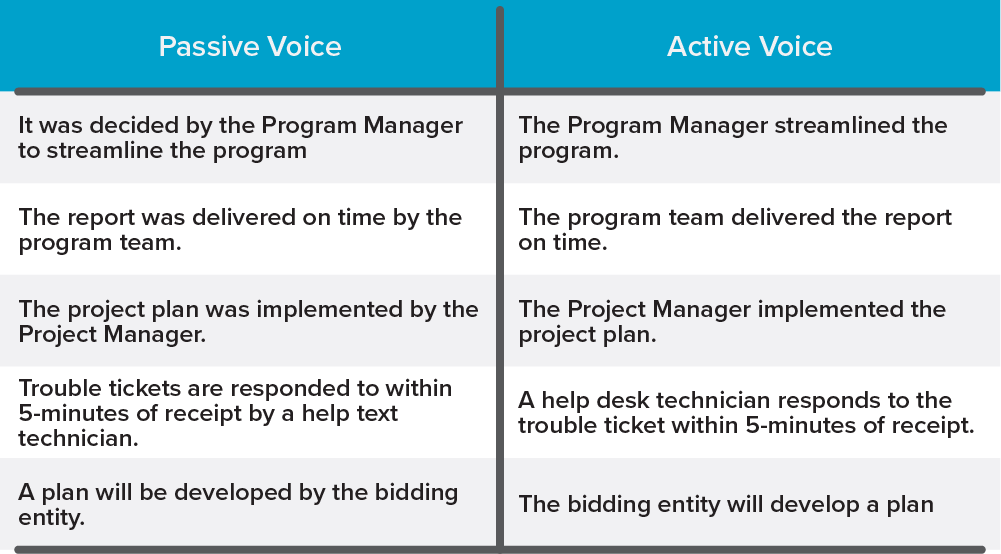
Finally, write in plain and concise language to make resumes digestible for evaluators:
"Wordy, dense construction is one of the biggest problems in government writing. Nothing is more confusing to the user than long, complex sentences containing multiple phrases and clauses." (plainlanguage.gov).
Many industries use specific terminology and jargon as well. As a result, readers can get lost without prior knowledge of an industry or subject. Avoid this by using simpler terms accessible to the public rather than strictly subject matter experts.

A second option is to explain the complex term within the sentence.
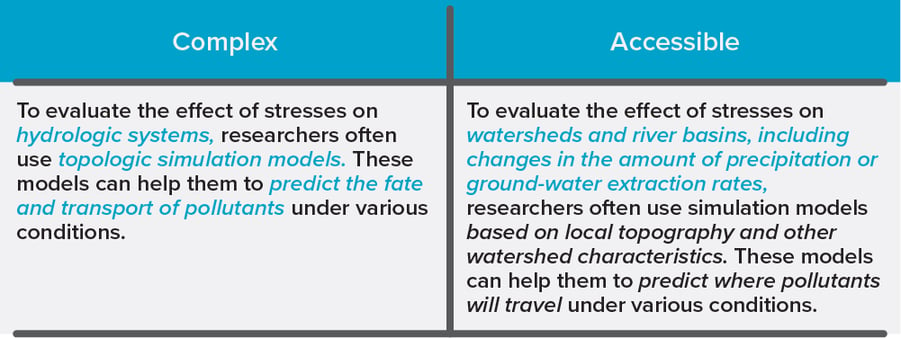
Adapt resumes.
When selecting candidates to propose, their experience may not always align with the solicitation. However, the candidate may have experience with transferable skills to sufficiently support the customer. For example, an experienced program manager may apply their expertise within one agency to another agency. Although government agencies differ in specializations, program management is adaptable to any environment. In this case, highlight a candidate's strengths in program management rather than the agency they supported.
As resumes typically include page limits, it is important to include only relevant experience tailored to the customer rather than broad and generalized experience. By targeting information pertinent to the proposed role on the contract, a resume will be compelling regardless of length.
3. How to Create an Easy To Evaluate Resume
Finally, aim to match key terms from the solicitation to the candidate's experience. Using the customer's language demonstrates attention to the solicitation. It also simplifies evaluation by connecting the candidate's experience to the solicitation requirements. As a bonus, evaluators can use keyword searches for an easy compliance check if they choose to.
Guide evaluators through the resume with formatting.
- Bold important terms (Note: don't overuse this strategy as it can become distracting.)
- Include relevant RPF mapping in parentheses
- Create sub-headers
- Italicize customer feedback
- Make compliance tables in the resume
Below is an example of a resume with the techniques described above.
Conclusion
Creating strong proposal resumes demonstrates to evaluators that your company is bringing the best team to deliver the contract. To clearly illustrate the team's strengths, create resumes that are not only compliant but also compelling and easy to evaluate. Highlight accomplishments that matter to the customer—quantifying and qualifying where you can.
Additionally, aim to use strong verbs, active voice, and simple sentence constructions. Finally, use strategies to make the resume easy to evaluate; for example, bold important terms, include relevant RPF mapping in parentheses, create sub-headers, italicize customer feedback, and include compliance tables. Following these easy steps will help instill in the customer confidence that your team will provide high-quality, low-risk contract services—which could provide the tipping point to help score you that win. Need help with your resume writing? KSI's proposal writers are trained and certified in industry best practices.
Sources:
https://www.plainlanguage.gov/guidelines/
https://store.ksiadvantage.com/
https://writingcommons.org/section/grammar/parts-of-speech/verbs/strong-verbs/
https://library.prescott.edu/writing-center/language-wordiness.php



